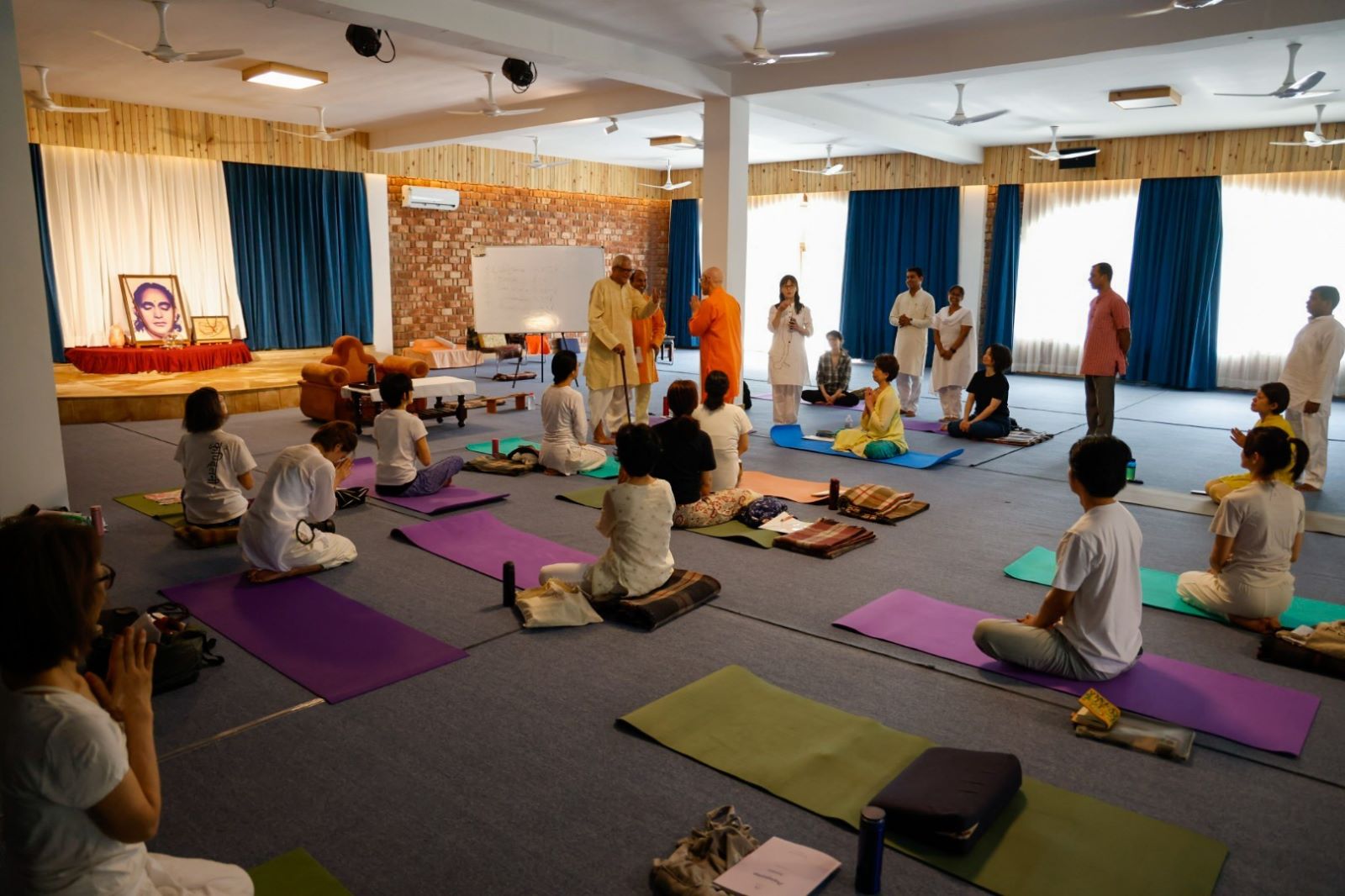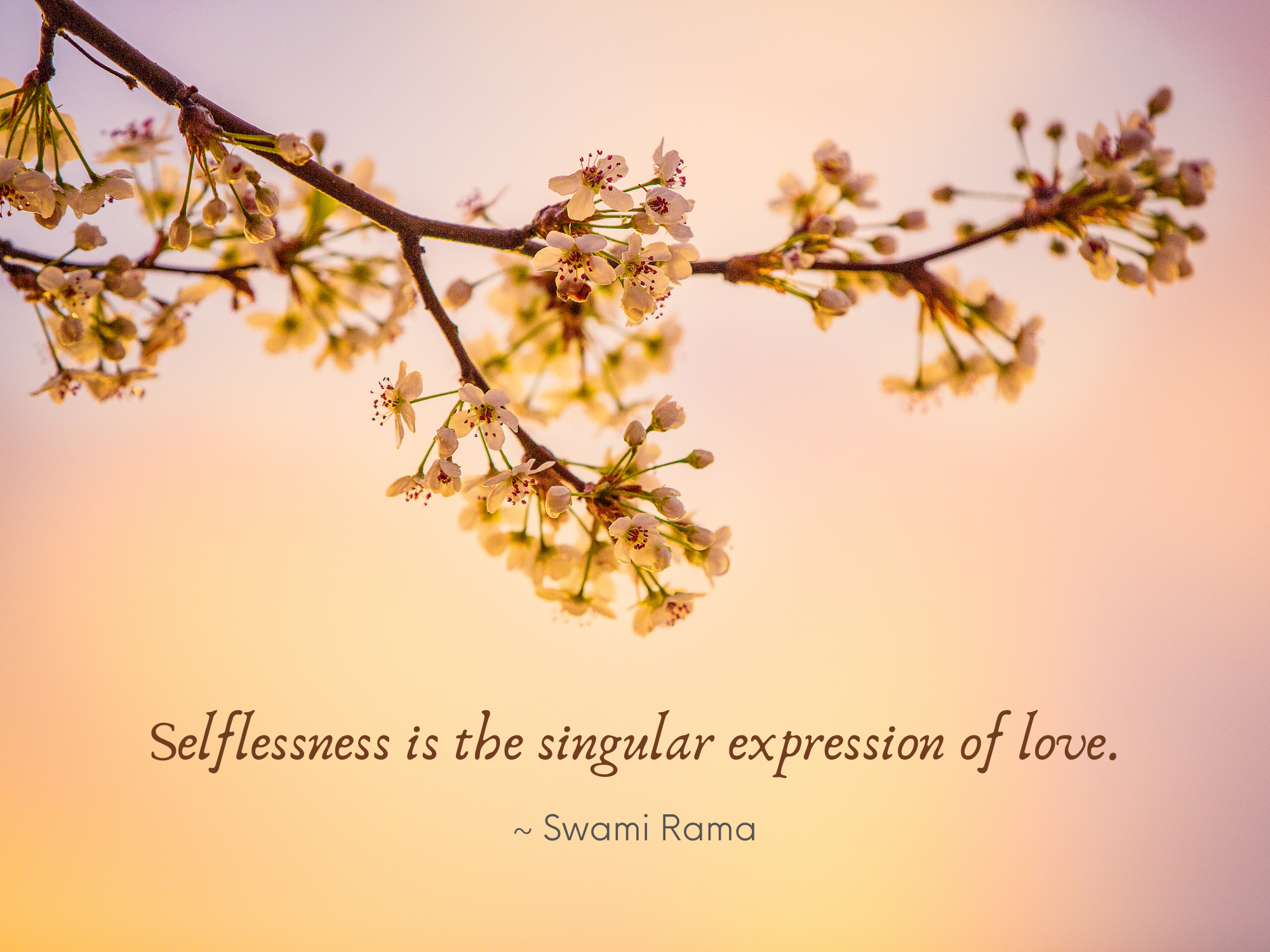As the one-year Gurukulam program approaches its conclusion, I find myself reflecting on the multitude of experiences gathered throughout this transformative journey. While this chapter of the Gurukulam is reaching its end, it feels more like the beginning of a long and continuous journey of self-transformation.
On the auspicious day of Dussehra, October 5th, 2023, the Gurukulam commenced with a morning Yajna. Following that, we had the privilege of visiting the Sadhana Mandir to pay our respects to our master Swami Rama and beloved Swami Veda Bharati. The day continued with an orientation led by Rabindra Ji, Divya Ji and the ashram teachers. During this session, we were acquainted with our daily schedule, informed about the expectations for the coming year, and encouraged to set our intentions for the coming one year.
Sitting in the meditation hall during this occasion, I was overcome with emotions and couldn’t believe my luck. It was truly surreal to be at the Guru’s home and to have been given this golden opportunity to immerse myself in this beautiful tradition and learn from its profound teachings.
As I embarked on this one-year journey, excitement filled my heart, but alongside it, I couldn’t escape the grip of self-doubting thoughts. I feared that I might not be able to make the most of this opportunity or navigate through it successfully.
However, whenever I found myself in need of guidance, I was incredibly fortunate to receive it from Swami Ritavan Bharati Ji, Rabindra Ji, and Divya. Their unconditional support and guidance remained a constant presence, turning this journey, despite its challenges, into a beautiful and fulfilling experience.
The curriculum at the Gurukulam was a wonderful blend of Bhakti Yoga, Jnana Yoga, and Karma Yoga. In the initial weeks, we delved into the philosophy of the Himalayan Tradition, learning the fundamentals of yoga and meditation within the Himalayan Tradition. Adhikari Ji introduced us to the basics of Himalayan Tradition. Jay Prakash Ji, affectionately known as JP Ji, skilfully taught us the nuances of correct sitting posture, diaphragmatic breathing, joint and gland practices, and asanas. I am deeply grateful to both of them for laying a strong foundation and preparing us for our meditation journey.
The teachings of Hatha Yoga, relaxation practices, breathing practices and all the subtle practices were not merely for physical health but served as preparation for our meditation practice.
As Swami Veda emphasized, every action throughout the day should be a preparation for our meditation practice, and that was the underlying theme of the Gurukulam. Everything we learned and were introduced to had the purpose of nurturing our minds and preparing our mind’s soil for the seed of meditation and spiritual transformation. The teachings were always centred around applying them in our daily activities.
Throughout the year, we were fortunate to learn from the teachings of our master Swami Rama and beloved Swami Veda. Their books and audio lectures have proven to be a treasure trove of experiential knowledge, constantly providing me with valuable guidance on my journey. I consider it a great blessing to have access to such profound teachings, and I am deeply grateful for the grace of the gurus that allows me to follow the path they have illuminated. Being a student in this tradition is a privilege I cherish wholeheartedly.
Learning at the Gurukulam was never about taking notes or engaging in intellectual discussions to merely understand philosophical texts at a surface level. Instead, there was a strong focus on sravana (attentive listening), manana (contemplation), and nididhyasana (implementation) of the teachings received. We learned how to receive information, engage with it thoughtfully, and then integrate it into our lives.
Throughout the one-year duration, we explored various philosophical texts like Shiva Sankalpa Sukta, Samkhya Philosophy, Tattva Bodha (a foundational Vedantic text), Sadhana Panchakam, Bhagavad Gita, Yoga Sutras, and Dakshinamurthy Stotram.
The exposure to these profound texts helped me develop a personal philosophy of life and refine my spiritual goals. The philosophy classes provided insights into the purpose of my life, my spiritual practices, and understanding questions like Who am I, what is the meaning of human existence, how does the mind function, what are the obstacles to watch out for and many more such thought-provoking queries. Though I still consider myself a novice in my understanding, the learnings of this year have taught me the right attitude to approach these texts and align my life with the wisdom imparted by the ancient sages.
One of the most beautiful experiences during this time was learning Vedic chanting. The energy we felt during the chanting and the profound stillness afterward were truly indescribable. I am deeply grateful to Prabha Ma’am and Rabindra ji for their dedicated efforts in working with us on this aspect. It must have been quite a challenge, and I appreciate their commitment to imparting this sacred knowledge.
The Ayurveda sessions provided us with insights into holistic health. We learned the significance of maintaining a dinacharya (daily routine), a balanced diet, and a lifestyle that supports our spiritual practice and doesn’t hinder our progress.
I express my thanks to Pierre Ji for dedicating his valuable time to our practice teaching and in helping us refine our skills in asanas, joint & glands practices, breathing, and relaxation techniques. His constant encouragement and valuable feedback motivated us to strive for improvement.
Participating in the Karma Yoga sessions at the ashram over the past year has been an incredibly wonderful experience. What made these sessions unique was the profound bhava (attitude) with which we were taught to approach these activities. I learned the true essence of seva (selfless service) and the importance of approaching it with the right mindset – understanding surrender, the ability to give and share without expectations, taking initiatives, and working harmoniously with others, even when differing in attitude and opinion. These sessions provided excellent opportunities to apply our practices in action, observing how my breath and state of mind influenced my approach to each activity and how I felt during and after completing them.
This surreal experience completely changed my perception of karma yoga. I had never imagined that such a deep and meaningful approach could be applied to it. These sessions became one of the most valuable learning experiences for me.
Being part of the AHYMSIN Sangha Gathering was a great privilege for us. It provided us with a unique and precious chance to be in the presence of senior members of our spiritual family, actively engaging with them and absorbing their wisdom. Listening to their experiences and receiving their guidance was an invaluable and rare opportunity that I deeply appreciate. The love and warmth we received from all the sangha members were truly awe-inspiring, and these moments will forever remain close to my heart.
The perfect conclusion to this transformative year came with sessions with Swami Ritavan. Despite not feeling well, Swami Ji graciously spent time with us, sharing with us his wisdom on how to approach the path ahead and how to integrate all that we have learned during this past year. He reminded us time and again that this is just the beginning of a beautiful journey on the path of yoga and meditation. The more we practice with sincerity and discipline, the further we progress.
The learnings I have gained in this one year are too vast to be contained in a single article. My experiences at Gurukulam have made me understand the utmost importance of satsanga (spiritual association) and swadhyaya (self-study). I have learned to align my lifestyle, goals, and vision to support my spiritual practices. I have developed the ability to analyse whether my thoughts, actions, and words are conducive to my spiritual growth or not. Though I am an amateur in my understanding, I acknowledge that this year at the Gurukulam has provided me with insights into how to approach and live my life. Although my understanding has not yet reached its full depth and sensitivity, I am appreciative of the newfound wisdom that has already enriched my journey so far.
My heartfelt gratitude goes to Swami Ritavan Bharati Ji and all the ashram teachers for their dedicated efforts in working with us throughout this year. They patiently worked on refining our rough edges and provided us with the wisdom of the Himalayan Tradition. At each step we were guided as per our individual capacities and inclinations.
This year has been the most profound and meaningful experience of my life, and the knowledge gained here will serve as the strong foundation for the years to come. I am eternally thankful for this incredible journey and the life-changing experiences it has offered me.
I pay my homage to the Guru Lineage.
Editor’s Note:
Swati is an initiate within the Himalayan Tradition. She holds a PhD in Psychology and has been a student at the Swami Rama Dhyana Gurukulam at Swami Rama Sadhaka Grama Ashram in Rishikesh.





